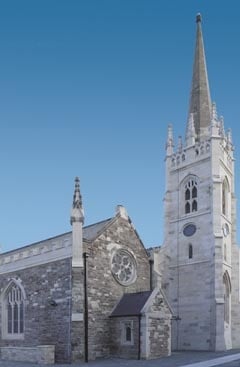Readers projects : Cunningham restore the faith
Cunningham Stone NI Ltd complete a £2million restoration project at St Mark’s Church, Newtownards, Co Down
The scaffolding is finally down and after four years of intricate work, the people of Newtownards, Co Down, in Northern Ireland can once again appreciate the beauty and splendour of their church, the newly restored St Mark’s.
The Grade A listed early 19th century Gothic church was originally built of the local Ballyalton sandstone. That is no longer available and considerable effort went into finding a good match for it. The solution was Mint sandstone from India. It was not a solution based on cost, says Director Alan Cunnigham, but compatibility. He says the stone cost no less than buying English stone. They imported block to be processed in their own restoration factory by their sawyers and masons.
After the scaffolding had been removed, a service of thanksgiving and rededication was held at the church.
The project has restored this once crumbling building into a now glorious place of worship and an architectural icon. The rector, Cannon Ken Smyth, who has been in the parish for 26 years, is justifiably proud of the Church of Ireland building that dates back to 1816.
“The stonework had deteriorated to such an extent that if something wasn’t done there would have been major problems,” he said, adding that parishioners and the community in Newtownards should be proud of their neo-Gothic building.
The project was funded by a number of different bodies: The Heritage Lottery Fund, an Environment and Heritage Service Award and the Representative Church Body Fabric Fund, with the remaining monies coming from the fundraising efforts of the parishioners.
During the restoration process as much as 90% of the church’s stonework in the tower was replaced.
Alan Cunningham, Sales Director for Cunningham Stone NI Ltd, was involved in this project from the beginning. “It has been an honour to be part of this project – we are very proud of the finished product. It is a fantastic showcase for the company and our dedicated skilled craftsmen.
“There was a huge amount of detailed stonework to replace on the building, including tracery windows, buttress quoins and caps, string courses, crenulations, arched balustrades, carved pinnacles and ashlar stonework.
“There were 18 carved pinnacles, each 2.7m high, which were made by our masons and carvers in Kilkeel.
“Each pinnacle took 15 weeks to make by hand. The quality of the finished product is something that the masons on site and the craftsmen in our workshops can be very proud of.”
Douglas Thompson, parish project manager, described the restoration as a labour of love for all the parishioners.
“All the craftsmen involved in the project were from Northern Ireland, including local stonemasons. The work is superb. You look up at some of the faces on the gargoyles – those are all carved by local people and it is great to see that skill is still available.”
The design team and consultants involved consisted mainly of DSC Partnership headed by the architect Robin Scott and stone consultant John Kelly from Lithan Ltd.
Cunningham Stone are specialists in stone restoration and the manufacture of natural stone architectural products. “We have been involved in a number of large restoration projects over the past few years, including St Peter’s Cathedral in Belfast and Armagh Cathedral,” says Alan Cunningham.
They have also recently launched natural stone panelling system called Tessela. “We’re getting work because we’re chasing hard to get it,” says Alan.
A short history of St Mark’s
Almost 1500 year ago in 540AD, one of the earliest Christian settlements in Ireland was founded by St Finnian at Movilla. Local tradition claims that St Columba attended the abbey as a student.
In 1244, the Dominicans visited the area and built a Priory. Each year within the remains of that Priory in Court Street, present day parishioners meet on or near St Columba’s Day in June.
On that site a small Church of Ireland community worshipped in the 18th Century. However, the building was insufficient to meet the needs of a growing population and in 1817, St Mark’s Parish Church was built. Forty years later the north aisle was added, increasing seating capacity to around 650.
In 1992 extensive repairs were carried out to the interior of the church, including the creation of St Columba’s Chapel.
Today St Mark’s sits with pride of place on Church Street and is opened most days.

